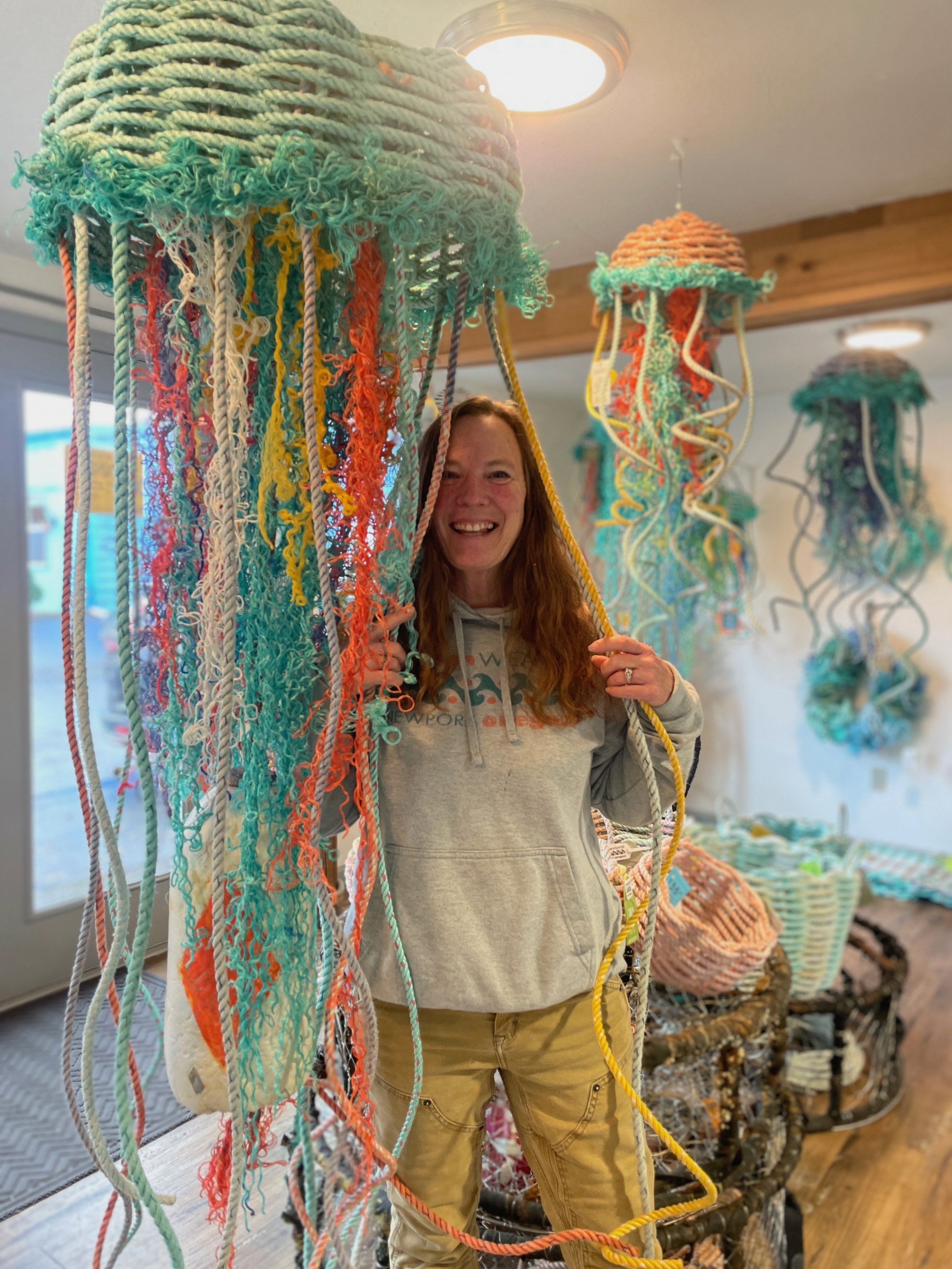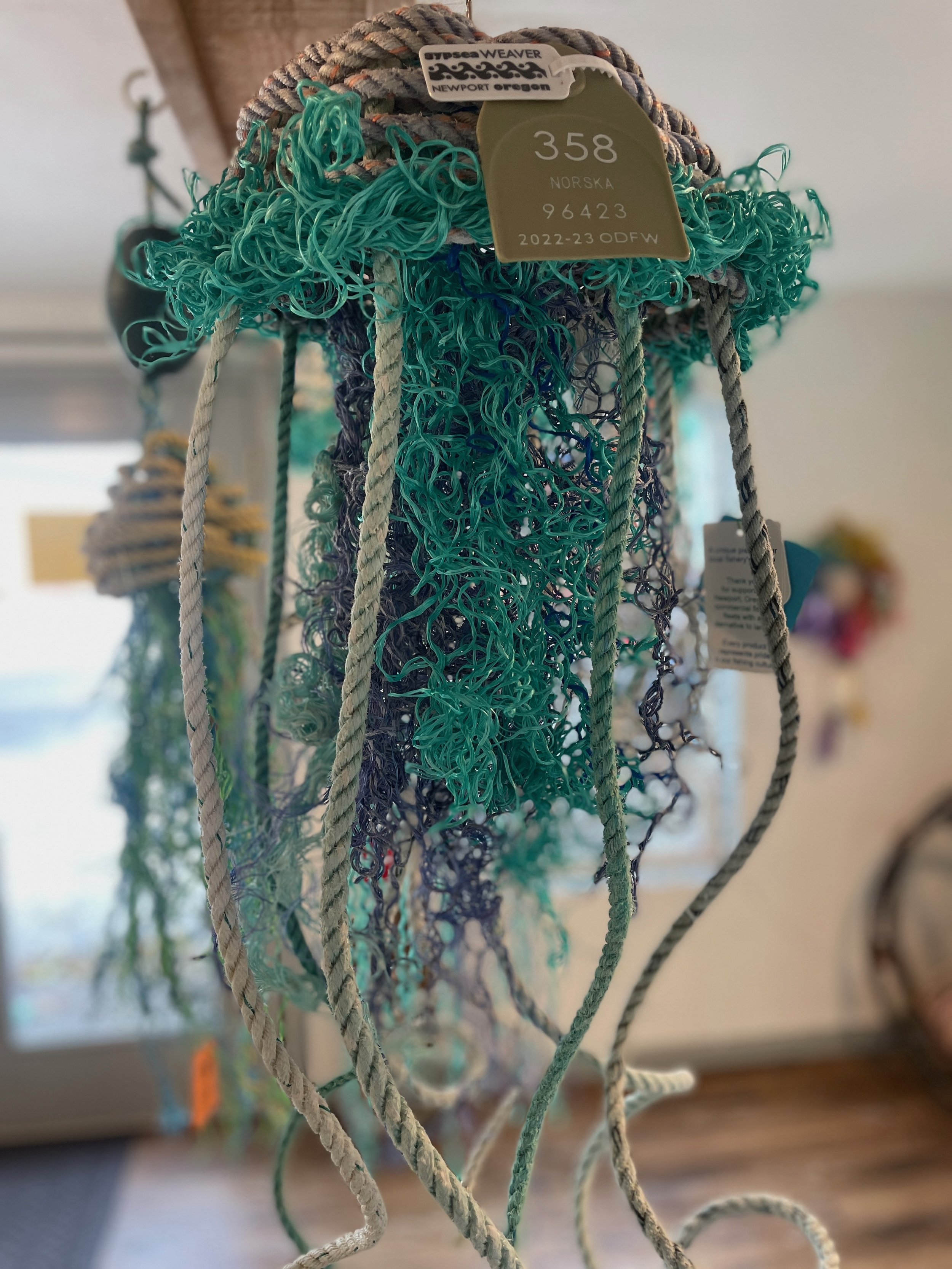Knot to be missed
Weave been longing to tell you about The Gypsea Weaver



Take a deep breath, then enter the magical underwater world of the Gypsea Weaver in Rebecca Hooper’s appropriately placed studio in Newport’s Aquarium Village. Hooper's distinctive jellyfish hover over robust doormats and baskets of many shapes, sizes and colors, all made with retired crab line and fishing rope.
Her creations have established a dedicated following that can't seem to get enough of them.
"This shop has been wildly successful,” she said. “At the end of some days, it looks like I've been robbed." Beyond serving as a retail store and creative space, her studio becomes a hub for engagement with customers, complemented by her delightful canine ambassadors, Kip and Penny, who add a touch of warmth to the inviting atmosphere. “They’re almost a marketing tool,” she said. “When you first walk in, because it’s a small shop, it looks like we might be expensive. The dogs relax most visitors and then they see my prices aren’t high after all.”
Hooper's journey into repurposing retired maritime gear traces back to a local art show, where she aimed to capture the attention of the curators for a subsequent juried event. A seasoned weaver and former freshwater biologist, Hooper explains her thought process, saying, "I felt that there was something passionate and emotional about beach debris that told interesting stories. But then I thought, ‘The curators are not going to want art that represents garbage on Newport’s beaches. It doesn’t represent our community; the Port of Newport is the gem.’” This sparked her discovery of Dave Carter’s innovative lobster rope doormats from the ’70s and the resulting movement of repurposing retired fishing line into functional items, all around the world. Her weaving now focuses on discarded materials from Newport’s fishing and crabbing industry that authentically encapsulate the community's maritime heritage.
A feature of Hooper's pieces is the incorporation of expired commercial crabbing permit tags, some graciously donated by original boat owners while others shamelessly collected from the bottom of the Port of Newport’s dumpsters. This connection between the fishermen and their Dungeness crab-loving customers adds a layer of authenticity to her creations.
"There is an impression from some folks that fishermen are wasteful by throwing away good rope,” she said. “Frankly, that couldn’t be further from the truth. They are the last people who want to throw away rope — if they can get another season out of it, they will. It’s expensive to replace!" Some boat owners have even become enthusiastic contributors, bringing their retired crab line and expired tags directly to her studio to be part of the artistic metamorphosis.
Within the spatial expanse of her studio, Hooper finds the freedom to explore new ideas, giving rise to popular original creations like her intricate rope jellyfish.
"I had been chewing on the idea of a jellyfish design for a few months when one day I noticed a bunch of unraveled rope scraps left over from tapestry weaving experiments I had been exploring,” she said. “That was the big a-ha moment, and the jellyfish design finally came together.” The evolution continues with recent additions to her repertoire, including stunning wreaths with a coastal flair and her clever mushroom-hunting baskets, designed to minimize spillage and promote spore distribution — a design she has been working out for months and which hit the showroom floor just last week.
"My goal over time is to move more of my work to the artistic side of weaving,” she said. “I love creating new ideas and one-of-a-kind pieces of art." Customers are not only drawn to the functionality of her creations but also to the artistry and the profound connection to the local fishing culture and the environment.
Either way, Hooper is finding that once they find her, customers keep coming back. "People come in and get one thing, and then it’s almost like an addiction.” she said. It usually starts with the functional and then ends up with the art because it’s just so fun, and the connection to our fisheries and the reuse aspect are things that people get excited about. Their enthusiasm fuels my creativity.”
For those that don’t catch up with Hooper in her studio, there are opportunities to find her in the wild. She actively participates in various events including the upcoming Pacific Maritime Heritage Museum artisan show this weekend and the highly anticipated Newport Seafood and Wine Festival in February. The excitement builds as she prepares for her inaugural one-woman show in the Fiber Arts Gallery at the Lincoln City Cultural Center in June.
In essence, Hooper’s creations serve as a powerful testament to the rich maritime heritage of Newport. Through forging connections between discarded maritime materials, the local fishing industry, and the community's profound appreciation for sustainable, repurposed art, the Gypsea Weaver Studio becomes a living narrative of innovation, passion and environmental consciousness.
The Gypsea Weaver Studio, located at 3101 SE Ferry Slip Rd #810 in Newport's Aquarium Village, extends a warm welcome to visitors Tuesday through Saturdays from 10 am to 3 pm during the winter. For more information, go to gypseaweaver.com, where the spirit of art and sustainability continues.
